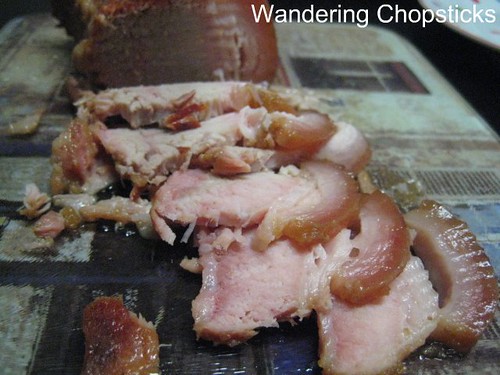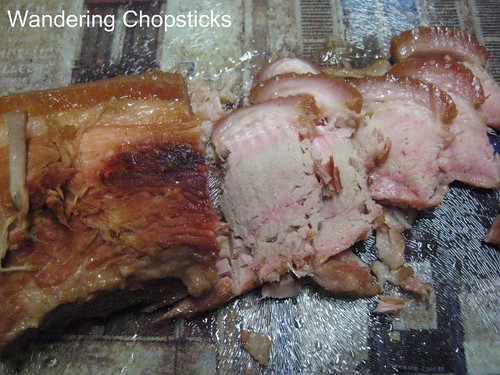
While serving ramen with char siu (Chinese barbecued pork) was tasty, I wanted to go all-Japanese the second time around when I made shichimenchou (Japanese turkey) ramen. I remembered Kirk of Mmm-yoso's recipe for buta no kakuni (Japanese braised pork). It's apparently based on the Chinese version, and looked amazingly similar to thit kho (Vietnamese braised pork). Even down to the hard-boiled egg.
So I decided I would largely cook the buta no kakuni the same way I would the Vietnamese version, subbing out such Vietnamese ingredients as the caramel sauce and fish sauce for Kikkoman soy sauce and grated daikon. Kirk's use of the grated daikon was ingenious. The meat was so incredibly tender.
I prefer using a leg or shoulder portion of pork with skin on to cut down on the fattiness. Use pork belly if you wish, but after a few bites, it may become a bit too much.

Buta No Kakuni (Japanese Braised Pork)
Adapted from Kirk of Mmm-yoso's buta no kakuni
For 1 1/2 lbs, you'll need:
1 1/2 lb pork, leg or shoulder portion with skin on
3-inch length of daikon, finely grated
1/4 cup soy sauce, Kikkoman brand
2 tblsp sugar
1/4 cup rice wine or mirin, if you have it
2 cups water
Finely grate half of a daikon, about 3 inches. Set aside.
I like to use my cast iron pot for braises since it retains heat better, thus reducing the cooking time. On high heat, quickly sear the pork on both sides. Then add the grated daikon, 1/4 cup soy sauce, 1/4 cup rice wine, 2 tblsp sugar, and 2 cups water.
Then turn the heat down to medium-low, partially cover the pot, and let the pork cook for at least 45 minutes to an hour, flipping it half-way through. If the marinade looks too dry, you can add a bit more water.
Serve with rice or ramen or make into fried rice.

Enjoy!
My other braised pork recipes:
Suon Kho Xa Gung Toi Ot (Vietnamese Braised Pork Chops with Lemongrass, Ginger, Garlic, and Chilies)
Thit Heo Kho Voi Dau Hu (Vietnamese Braised Pork with Tofu)
Thit Heo Kho Voi Trung Hoac Gai Chua (Vietnamese Braised Pork with Eggs or Pickled Mustard Greens)
Xiu Mai (Vietnamese Meatballs)

Oishi Oishi!!! Wow, you have gone ALL JAPANESE! Salivating over your bowl of ramen, wish I could taste the soup.
ReplyDeleteEver since you started the ramen posts, I've been eyeing that buta no kakuni and wondering if you were going to post a recipe. It's so fall-apart-wonderful looking!
ReplyDeleteOh My Goodness.....looks sinfully good. Nice job....the daikon is a fairly unconventional touch for Buta No Kakuni, but seems to work well.
ReplyDeleteWow! That look SO freaking good. I love the pig and all its delicious bits. Luckily I have a pork shoulder in the freezer...now I know just what to do with it. Thanks!!
ReplyDeleteFall-apart tender and lipsmackingly good. Amazing and great on top of ramen. Great stuff!
ReplyDeleteThat does look awesome! Does the daikon do any tenderizing or is it just for flavor?
ReplyDeleteRecently posted about this, too. It's a beautiful dish. I'm addicted to anything pork belly ;)
ReplyDeletehello, i've been reading your blog for some time now, and consequently have started my own, thanks to you and others. I like your little section on the side which talks about starting your blog...i wish i did it earlier when i was in sd. i love your ramen stock post too...keep em coming!
ReplyDeleteThat pork is melting in my mouth. I know that I would love this because you use the same basic ingredients that we used in my Japanese cooking class for cooking vegetables - shoyu, mirin and sugar. Those three ingredients make any vegetable taste good. The only thing missing is the dashi.
ReplyDeleteWeather's getting cold....I'm going to make ramen this weekend. Thanks!
ReplyDeleteohoho baby! i think i can try this on my almost brand new shiny pressure cooker. oh yeah!
ReplyDeleteOh wow, this looks so delicious and melt in the mouth!
ReplyDeleteMmmm, what a creative recipe! Love it, thank you so much!
ReplyDeletePP,
ReplyDeleteThanks! It took a lot of work! I don't often cook Japanese food.
Nikki,
You know I'd eventually cough up the recipe. :)
Kirk,
I loved how tender the daikon made the pork. And grating it was a wonderful way to get the flavor, but to blend in seamlessly.
BB,
I hope you try the recipe. It's really easy, just let it slow-cook and you're good to go.
JS,
Thanks!
MaryRuth,
The daikon definitely tenderized the meat. It also adds a slight bit of sweetness so you can cut down on the sugar.
Jude,
Me too. But too much pork belly is so bad for you.
Mother may I,
I'm glad you found the blogging series useful. Gotta get around to writing up the final chapters.
Susan,
I haven't attempted dashi yet. I really don't cook with Japanese food too much so I'll have to try that some day.
Jan Frederick,
Let me know how it turns out!
MCR,
Yeah, give your pressure cooker a workout. :)
Jo,
Thanks. The pork did fall apart in the mouth. Actually, even before then.
Jesse,
Thanks. I didn't do much creativity, just tweaked Kirk's recipe.
This made me thick of a similar chinese version that my grandma makes. Just looking at the photo reminds me of how melt in the mouth it is! Yours look really tempting and shinning!
ReplyDeleteDaphne,
ReplyDeleteWell, the Japanese version is based upon the Chinese version. That's probably why I thought it was similar to the Vietnamese version as well.
Well, I made the shio broth and this for ramen the Sunday before thanksgiving. I had a bunch of leftover prawn shells from the curry dish I made for my in-laws and so I added those to see if it would lend a little complexity. I also had an onion and a teeny tiny bitty knob of ginger in there. I let it go for 6 hours.
ReplyDeleteI'm have an inexperienced pallete when it comes to ramen broth, so I can't tell you how it was in comparison to many shops. But I will say that it was pretty darned good. The shells lent a subtle flavor that wasn't overwhelming, and the bones gave up all their porky goodness. The onions lent a nice vegetable note and the ginger was barely detectable.
The braised pork came out pretty good, but my cut didn't have the skin, so no nice pork fat. Also, I managed to overcook my ramen a bit. But no bother. It was good and a lot of fun to make. And contrary to what Kirk thought, it really wasn't much more trouble than a typical recipe. It just required a bit of monitoring.
So thanks again. It was a lot of fun making something that isn't made in 99% of American kitchens.
Jan Frederick,
ReplyDeleteYay! I love feedback like this. Not just that the recipe worked well for you, but that you tried something you normally wouldn't have attempted b/c of my blog. Happy, happy, joy. :)